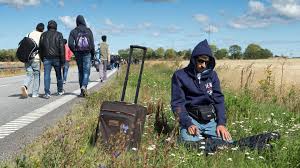Why Denmark’s harsh refugee rules could change the way the UK handles asylum seekers

Why Denmark’s harsh refugee rules could change the way the UK handles asylum seekers
Over the past decade, Denmark has earned a reputation for some of the strictest refugee and asylum policies in Europe. Central to its approach is the temporary nature of refugee status—a tool widely credited with discouraging asylum seekers from choosing Denmark.
Before 2015, refugees were typically granted residence permits for five to seven years, with automatic eligibility for permanent status afterward. However, the influx of over a million refugees into Europe in 2015—mainly from Syria, Afghanistan, Iraq, and Eritrea—prompted a dramatic shift in Danish policy.
Today, most refugees in Denmark are issued temporary permits lasting just one or two years. Permanent residency is no longer guaranteed; applicants must demonstrate fluency in Danish and maintain full-time employment for several years to be considered.
Michala Clante Bendixen, who heads the advisory group Refugees Welcome Denmark, explained the impact: “It’s about the feeling of being here temporarily. You don’t know what your future holds. Even a minor infraction, like a speeding ticket, can delay permanent status for years.”
Sharp Decline in Asylum Seekers
The reforms appear effective. In 2014, Denmark received 14,792 asylum applications, primarily from Syria and Eritrea. By 2021, that number dropped to 2,099 and remained low at 2,333 in 2024. Out of nearly 100,000 residence permits granted last year, only 1% went to refugees—excluding Ukrainian refugees, who are categorized separately.
Yet these policies have sparked criticism, particularly for the erosion of Denmark’s international reputation. Critics argue that adopting populist, right-wing ideas into mainstream politics has weakened Denmark’s traditional emphasis on human rights and minority protections. Rune Lykkeberg, editor-in-chief of Information, said: “Extremism in the centre makes it harder to justify human rights and protect minorities.”
Political Context
Since Mette Frederiksen’s Social Democratic government came to power in 2019, Denmark has doubled down on deterrence. Her predecessor, Lars Løkke Rasmussen, laid much of the groundwork with temporary residence rules and a shift toward prioritizing repatriation over integration.
Among the most controversial measures is the law on so-called “parallel societies,” which permits demolition of apartment blocks where over half the residents have a non-Western background. An EU court adviser recently ruled that the law constitutes direct ethnic discrimination.
Domestic debate has grown more extreme, with the far-right Danish People’s Party advocating for “remigration,” or mass deportation of people with immigrant backgrounds. Eva Singer of the Danish Refugee Council noted that much of the anti-immigrant sentiment is driven by political rhetoric rather than public opinion.
Lessons for the UK
The Danish model has attracted attention abroad. Britain’s Labour government is reportedly studying Denmark’s system as part of a broader effort to curb asylum applications. Home Secretary Shabana Mahmood is expected to announce sweeping reforms, including tighter deportation measures, stricter family reunification rules, and restrictions similar to Denmark’s temporary residency system.
UK officials have visited Denmark to assess how its policies have lowered asylum claims while staying within European human rights frameworks. Denmark now deports 95% of failed asylum seekers, while applicants must repeatedly reapply for residency—a process designed to dissuade “asylum shopping.”
Despite criticism from the UN and human rights groups, Denmark’s experience illustrates how temporary permits and strict integration requirements can sharply reduce new asylum applications—though not without social and ethical costs.
FAQs
Q: What is Denmark’s temporary residence system for refugees?
A: Refugees are initially granted permits for one to two years. Permanent residency requires fluency in Danish and several years of full-time work.
Q: Why is Denmark’s system controversial?
A: Critics argue it undermines integration, limits human rights, and introduces ethnic discrimination, particularly with laws targeting “parallel societies.”
Q: How have asylum numbers changed in Denmark?
A: Asylum applications fell from 14,792 in 2014 to around 2,300 in 2024, largely due to stricter rules and temporary permits.
Q: Why is the UK studying Denmark’s approach?
A: The UK aims to reduce asylum claims and deport illegal migrants more efficiently by modeling policies on Denmark’s system.

